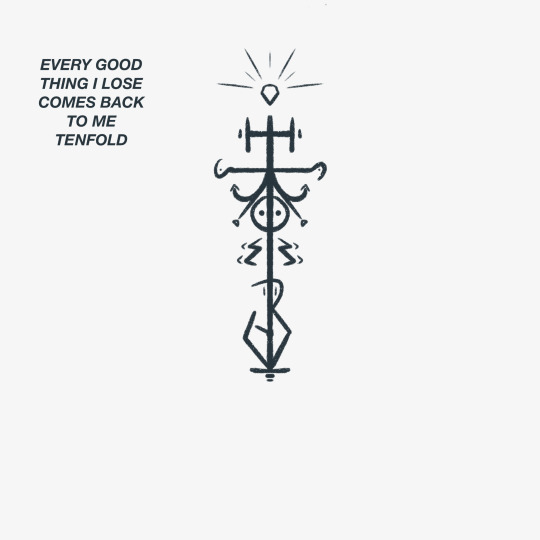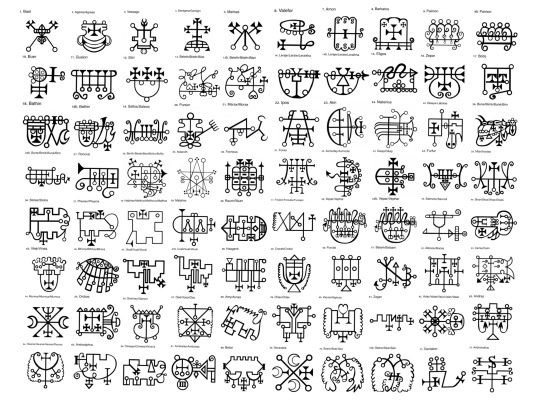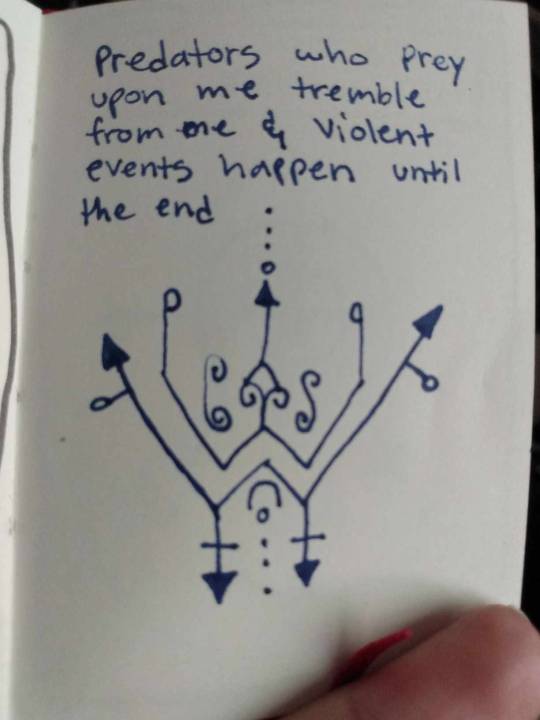#chaos sigils
Text

every good thing i lose comes back to me tenfold
#sigil#sigils#sigil magic#sigil magick#sigilcraft#sigil witch#chaos#chaos magic#chaos magick#magic#magick#witchblr#witchblog#witchcraft#witch community#my sigil#my sigils#occult#esoterica#affirmation#affirmations#manifestation#witches#ritual#ritual magic
613 notes
·
View notes
Text

#male satire#sigma male#angel technology#angelcore#divine machinery#john dee#mlm#angels#gay#mlm yearning#ted kaczynski#magic mike#mathew mcconaughey#gym crush#androphilia#sigil magic#mysticism#chaos magick#pagan#angel posts#this ken talks to angels
387 notes
·
View notes
Photo

72 SEALS FROM THE LESSER KEY OF SOLOMON
[2,048 × 1,519 PX.]
#sigil#chaos magick#paranormal#symbols#magic#aleister crowley#s.l. macgregor mathers#the lesser key of solomon#17th century#u#REF
1K notes
·
View notes
Text

It's magical. Well, well Old Friend... it looks like everyone is your teacher, no one is your master.
#magick#witchcraft#witchblr#chaos magick#magic#ritual#chaos magic#chaos magician#sigil magic#occultism#sigil#runes#deity work#demonolatry#black magic#left hand path#black magick#white magick#white magic#right hand path#The Middle Way#witches of tumblr#witch tips#witchy tips#writers on tumblr#the occult#tarot tips#tarot spread#tarot reading#teaching
490 notes
·
View notes
Text
Speaking to me is a privilege And you do not have privileges


#witchcraft#witchblr#pagan#witchy#sigil#sigil magic#sigilwork#sigils#witchcraft community#witch community#i'm so upset#so irritated#chaos magick
341 notes
·
View notes
Text
A Collection of Symbols
My symbology pages from one of my grimoires. I tend to do this in every book because I never fail to stumble across new sigils, symbols, and glyphs. Of course I must jot down my favorites. 🖤







#satanic witch#satanism#withcraft#demons#magick#witch#demonolatry#lefthandpath#dark#witchcraft#eclectic witch#chaos magician#chaos magick#sigil work#sigil#sigil magic#sigil magick#runes#glyph#symbology#symbols
136 notes
·
View notes
Text
Chaos Magick
Chaos Magick is a modern form of occultism that defies traditional structures and dogmas, embracing a pragmatic, results-oriented approach to magical practice. Unlike conventional magical systems that adhere to specific rituals, symbols, and deities, Chaos Magick emphasizes flexibility, personal belief, and the use of any technique or symbolism that achieves the desired outcome. Originating in the late 20th century, Chaos Magick has become a significant and influential movement within the broader landscape of contemporary occultism, attracting practitioners who value creativity, experimentation, and personal empowerment. This essay explores the history, principles, practices, and significance of Chaos Magick.

History of Chaos Magick
Chaos Magick emerged in the late 1970s and early 1980s as a response to the rigid structures of traditional ceremonial magick and the occult revival movements of the 19th and 20th centuries. The origins of Chaos Magick can be traced to the writings of occultists such as Peter J. Carroll and Ray Sherwin, who were instrumental in developing and popularizing this new approach to magic.
The Influence of Austin Osman Spare:
A significant precursor to Chaos Magick was the work of artist and occultist Austin Osman Spare (1886-1956). Spare's ideas about the subconscious mind, sigils, and the power of belief were highly influential on later Chaos Magicians. He emphasized the use of personal symbols and the manipulation of belief as tools for magical success, laying the groundwork for many of the ideas central to Chaos Magick.
The Birth of the Movement:
In the late 1970s, Peter J. Carroll and Ray Sherwin co-founded the Illuminates of Thanateros (IOT), a magical order dedicated to the practice and development of Chaos Magick. Carroll’s seminal works, "Liber Null" (1978) and "Psychonaut" (1982), became foundational texts for Chaos Magicians. These books outlined the core principles of Chaos Magick, including the emphasis on belief as a tool, the use of sigils, and the concept of "paradigm shifting," where practitioners adopt different belief systems as needed.
Spread and Evolution:
Throughout the 1980s and 1990s, Chaos Magick grew in popularity, particularly in the United Kingdom and the United States. The movement attracted individuals interested in a more personalized and experimental approach to magic, free from the dogmatic constraints of traditional systems. As Chaos Magick evolved, it incorporated influences from psychology, science fiction, pop culture, and postmodern philosophy, reflecting its eclectic and adaptive nature.
Principles of Chaos Magick
Chaos Magick is characterized by several key principles that distinguish it from other forms of magical practice. These principles emphasize flexibility, pragmatism, and the central role of belief in achieving magical outcomes.
Belief as a Tool:
One of the core tenets of Chaos Magick is the idea that belief itself is a powerful tool in magic. Unlike traditional magical systems that require adherence to specific beliefs or deities, Chaos Magick posits that the act of believing—regardless of what is believed—is what makes magic effective. Practitioners are encouraged to adopt and discard beliefs as needed to achieve their desired results, treating belief as a flexible and dynamic tool rather than a fixed truth.
Paradigm Shifting:
Closely related to the use of belief as a tool is the concept of "paradigm shifting." In Chaos Magick, a paradigm is a framework of beliefs, symbols, and practices that a magician temporarily adopts to work a particular spell or ritual. A Chaos Magician might shift between different paradigms—such as using Kabbalistic symbols in one ritual and invoking Lovecraftian deities in another—depending on what they find most effective for their goals. This fluid approach allows practitioners to draw from a wide range of magical and cultural traditions.
Pragmatism and Results-Oriented Practice:
Chaos Magick is inherently pragmatic, focusing on what works rather than adhering to tradition or doctrine. The effectiveness of a magical practice is judged solely by the results it produces. This results-oriented approach encourages experimentation and the development of new techniques, as well as the modification or abandonment of practices that do not yield desired outcomes.
Use of Sigils:
Sigilization, a technique popularized by Austin Osman Spare, is a central practice in Chaos Magick. A sigil is a symbol created by condensing a specific intention or desire into a visual form. The practitioner then uses various methods to "charge" the sigil with energy and launch it into the subconscious mind, where it works to manifest the desired outcome. Sigils are valued for their simplicity and adaptability, making them a popular tool among Chaos Magicians.
The Gnostic State:
Achieving a state of altered consciousness, often referred to as the "Gnostic State" or "gnosis," is a key component of Chaos Magick rituals. This state of mind, in which the practitioner is highly focused and free from distractions, is believed to be crucial for the successful performance of magic. Various methods, such as meditation, chanting, visualization, or sensory deprivation, are used to induce gnosis.
Practices of Chaos Magick
Chaos Magick is known for its eclectic and innovative practices, which can vary widely from one practitioner to another. The following are some of the most common practices associated with Chaos Magick:
Sigil Magic:
As mentioned, sigil magic is a cornerstone of Chaos Magick. The process typically involves creating a sigil by writing out a statement of intent, removing duplicate letters, and arranging the remaining letters into an abstract symbol. The practitioner then enters a Gnostic State, charges the sigil with intent, and either destroys or forgets the sigil to allow it to work subconsciously.
Magical Experimentation:
Chaos Magicians often experiment with a variety of techniques, drawing from different magical traditions, religions, and even pop culture. This might include invoking gods from different pantheons, working with fictional characters as if they were real entities, or incorporating elements of modern technology into rituals. The emphasis is always on what is effective for the individual practitioner.
Deconstructing and Reconstructing Beliefs:
Chaos Magicians regularly engage in the practice of deconstructing and reconstructing their beliefs. By deliberately adopting different belief systems, even those they do not inherently believe in, they explore the effects of belief on reality. This practice often leads to a deeper understanding of the fluid nature of reality and the power of the mind in shaping experience.
Use of Pop Culture and Modern Symbols:
One of the more unique aspects of Chaos Magick is its embrace of contemporary symbols and icons from pop culture. Practitioners might use characters from movies, comic books, or video games as symbols in their rituals, treating these figures as modern-day deities or archetypes. This reflects Chaos Magick's adaptability and its focus on personal relevance over tradition.
Psychological Techniques:
Many Chaos Magicians incorporate psychological techniques into their practice, drawing from fields such as cognitive psychology, NLP (Neuro-Linguistic Programming), and hypnosis. These techniques are used to alter consciousness, influence perception, and reinforce the practitioner’s intent. The integration of psychological methods underscores Chaos Magick's pragmatic and results-driven approach.
Significance and Influence of Chaos Magick
Chaos Magick has had a profound impact on modern occultism, influencing both magical practice and the broader cultural understanding of magic. Its emphasis on flexibility, innovation, and personal empowerment has resonated with a new generation of practitioners who seek a more individualized and adaptive approach to magic.
Democratization of Magic:
One of the most significant contributions of Chaos Magick is the democratization of magical practice. By rejecting rigid hierarchies, dogmas, and the need for formal initiation, Chaos Magick has made occult practices more accessible to a wider audience. Anyone can become a Chaos Magician, regardless of background or experience, as long as they are willing to experiment and learn.
Cultural Impact:
Chaos Magick has also influenced popular culture, particularly in areas related to the occult, science fiction, and the countercultural movements of the late 20th and early 21st centuries. Concepts from Chaos Magick, such as paradigm shifting and the use of pop culture symbols, have found their way into literature, movies, and art, reflecting the movement's broad cultural reach.
Challenges to Traditional Magic:
Chaos Magick challenges the conventional understanding of magic by questioning the necessity of belief in any particular system or deity. This has led to debates within the occult community about the nature of magic, the role of belief, and the effectiveness of traditional practices. Chaos Magick's focus on results over tradition has encouraged many practitioners to rethink their approach to magic.
Influence on Postmodern Thought:
Chaos Magick is often associated with postmodernism, particularly its skepticism of grand narratives and its emphasis on individual experience. The movement’s fluid approach to reality, belief, and identity aligns with postmodern ideas about the constructed nature of reality and the multiplicity of truths. This has made Chaos Magick particularly appealing to those who resonate with postmodern philosophy.
Conclusion
Chaos Magick represents a radical departure from traditional magical systems, offering a flexible, pragmatic, and highly individualized approach to occult practice. By emphasizing the power of belief, the importance of personal experience, and the value of experimentation, Chaos Magick has redefined what it means to practice magic in the modern world. Its influence extends beyond the occult community, challenging cultural and philosophical assumptions about reality, belief, and the nature of power. As a living, evolving tradition, Chaos Magick continues to inspire and empower those who seek to explore the mysteries of existence on their own terms.

#mysticism#occultism#metaphysics#mystic#magick#chaos magick#sigil magick#witchcraft#witchblr#witch#wicca#grimoire#chatgpt
136 notes
·
View notes
Text
I got another witchy FAQs question so I want to go ahead and share it.
This time, we're talking some basic chaos magic with different types of thoughtforms!
Please note that I am not an expert in chaos magic, nor do I consider myself a chaos magician, so feel free to (kindly) leave feedback or corrections as needed. ^^
Thoughtforms 101
Definition of Thoughtform: Thoughtform is a catch-all term from any entity that was created with or by human thought (conscious or otherwise).
Types of Thoughtforms: Common thoughtforms include sigils, servitors, thoughtform companions (aka tulpas), daemons, and egregores.
Sigils: Most folks who create sigils and use sigil magic probably don't think about sigils as a type of chaos magic or a thoughtform. However, sigils actually do fall into this category. Think of a sigil as being like a simple computer program that's powered by your mind. You give the program a basic function (such as protection or prosperity) and the magical "coding" of your intentions allows the sigil to carry it out.
Servitors: If sigils are basic computer programs, then servitors are robots. They're not sentient per se, as they still require the coding and programming that comes with intention and magical energy. Yet they're much more complex than a sigil and can carry out higher-level functions & multiple tasks (e.g., drawing in people to shop on your Etsy page for prosperity, or actively guarding a space or casting a magic circle for protection).
Thoughtform companions: The widespread term for this type is "tulpa," and creating/having one of these thoughtforms is commonly referred to as "tulpamancy." Since there's also a widespread controversy over these terms, I don't use them myself. I say "creating or working with a thoughtform," and I'll refer to the entity as a thoughtform or thoughtform companion. Regardless of the terminology or beliefs behind this category, they are defined as a separate consciousness created by the thoughts and actions of a human. The human is typically referred to as the "host," since the companion is typically treated as its own separate consciousness. These are fully sentient, autonomous beings with their own thoughts and feelings. They're generally created, either intentionally or not, as friends for the host (hence my personal terminology for them).
Daemons: This category is similar to a companion, but with a different origin and function. Daemons have been documented since ancient Greece, to my knowledge. A daemon is also a sentient entity, however, they are not created intentionally by the host (although they can be brought to the forefront by the human in question). A daemon is instead a conscious entity created by, and representative of, the human being's subconscious mind. They typically serve as helpers and mental guides for the human. They are not considered separate entities; instead, they're part of you.
Egregores: These are essentially the AIs of the thoughtform world. Whereas companions and daemons exist within the human mind, egregores are similar to servitors and sigils - created by the mind, but separate from it. Egregores are often made or manifested by a group of people intentionally for a purpose. E.g., a coven may create one as a guardian or a spiritual guide. They're also often created by accident from widespread symbols - for example, branding. And nations. Every time somebody posts a picture of the Starbucks logo, you're most likely feeding an egregore, according to one theory I've heard. Do I believe that personally? Not sure. (I do have an exact source for this one available on request.) As far as I know, egregores exist with varying degrees of sentience, power, and free will depending on the individual scenario (much like artificially intelligent computers & androids in science fiction).
Pop Culture Entities / Deities: These are often referred to as PCEs or PCDs. I prefer the former but I often use them interchangeably. Some folks prefer to be more specific. For example, Raiden from Mortal Kombat is considered a god in that series, so many folks would consider him a pop culture deity. Whereas Dean Winchester is *not* a deity in Supernatural - so he could be considered a pop culture entity instead. However, this is up to the preferences of the individual entity & practitioner.
Differences between PCDs and Egregores: Egregores are ALWAYS created, intentionally or not, by human energy and thought. PCDs, on the other hand, can have a mixed origin sometimes. Some of them may be pure egregores, manifested on purpose or by accident. Others may be preexisting spirits - often nature spirits that are aligned closely to the fandom content - that latch onto a fictional work as a power source, and eventually fuse with it. And then another theory is that PCDs are *all* preexisting spirits or even deities wearing a mask - so for example, folks with this belief would say that PCD Marvel Loki is just Loki appearing in a different form/aspect. I personally think that all PCEs have a unique origin and I try not to make any assumptions.
Where do I fact check you and/or learn more?: Unfortunately, it is *really damn hard* to find good, solid information on pop culture work because it's very new. And while there's *lots* of info on chaos magic, you have to be careful to check the reliability of the source, much as is the case with demonolatry sources. Fortunately, Tumblr is a great source to find other pop culture practitioners. I personally also have *some* sources available for these topics on request, I'm just too lazy to dig through my Drive right at this moment. :)
#thoughtforms#tulpamancy#chaos magician#chaos magic#sigils#servitors#egregores#pop culture paganism#pop culture witchcraft#pop culture magic#witchy tips#witchblr
260 notes
·
View notes
Text
The obsession with closed practices and “cultural appropriation” is Fucking ridiculous and racist af.
ALL magick systems are derivative. All magick practices are based on and inspired by other magick practices.
This obsession with gatekeeping practices is covert bigotry. As long as you treat it with respect and actually do your research your fine.
If you use jar spells your using a Hoodo spell. But because it’s trendy no one bats an eye. But god forbid you call it hoodoo because then you’re appropriating a “closed” practice.
All this attitude does is create more division.
I’ll use any kind of magick I want. Don’t give a fuck. Get over it.
#chaos magick#magick#witches of tumblr#witchcraft#sigil#sigils#technomancy#witchblr#eclectic witch#rant
249 notes
·
View notes
Text
Colour Magick Correspondences & Ideas
*longer read*
Pretty easily applied for both beginner, closet and experienced practitioners alike! Can be used in most areas of mundane and magickal life (with some ideas listed below).
White
→ Cleansing, clarity, blessing, healing, innocence, truth, connection to spirits or the spiritual world, divine connection, consecration, dream work, psychic connection, purity, rest, moon magic, angelic work, devotion, harmony, prayer, peace, purification, universal truths. White can also be used as an all-purpose color for your intention when the color you want is not available.
Black
→ Banishing, transformation, uncrossing, endings, domination, protection, reversing, repulsion, freedom from evil, cursing, cloaking, sophistication, security, emotional safety, closure, breaking patterns, grief, mourning, absorbing, removing, trapping, encasing, the unconscious, mystery, shielding from the evil eye, *similarly to white - as black is an absence of colour it can be used for any colour if you don’t have them available* - personal opinion
Red
→ Passionate love, energy, action, attraction, sexuality, magnetism, will, force, anger, fire within, courage, warmth, lust, drive, pleasure, vitality, vigor, excitement, desire.
Orange
→ New opportunities, new ventures, new beginnings, change of plans, encouragement, opening the way, removing blocks, physical comfort, warmth, security, ambition, creativity, courage, optimism.
Yellow
-> Optimism, prosperity, happiness, good luck, attraction, success, confidence, visibility, fame, self-esteem, communication, concentration, focus, inspiration, intellect, logic, memory, knowledge, learning.
Green
→ Prosperity, abundance, wealth, generosity, money luck, career, growth, fertility, gambling luck, business, a good job, harmony, balance, healing, self-love, altruism, universal love, contact with fae and nature spirits.
Blue
→ Reconciliation, harmony, peace, kindness, healing, ideas, intelligence, wisdom, loyalty, sleep, meditation, communication, creativity, dream work, trust, blessings, calm, forgiveness, truth, bliss, inspiration, fidelity, honesty.
Purple
→ Healing, calming, tranquility, spirituality, meditation, pacification, cooperation, sensitivity, compassion, empathy, selflessness, empowerment, controlling, commanding, mastery, power, ambition, achievement, charisma, luxury, expansion, psychic ability, spirituality, authenticity, truth, transformation, insight, justice, wisdom, politics, divination, ESP, intuition, wishes, influence.
Pink
→ Romantic love, friendship, soul mates, sweet feelings, emotional healing, heart connection, affection, family love, admiration, physical tranquility, nurturing, warmth, youthfulness, healing grief, compassion, forgiveness, beauty, unconditional love.
Brown
→ Justice, balance, grounding, court cases, legal matters, being down-to-earth, practical matters, seriousness, reliability, support, stability, safety, earth, nature, animals, home, nostalgia, basic needs being met, balance.
Grey
→ Neutrality, neutralizing, invisibility, working in “gray areas,” anonymity, hiding from others, working in-between worlds, secrets, occult and arcane wisdom, reversing, uncovering mysteries and secrets, lifting curses, undoing prior spell work.
Silver
→ Dreams, intuition, psychic work, courtesy, honor, moon magic, rhythm, cycles, divination, illusions, glamour spells, wisdom.
Gold
→ Prosperity, fame, luxury, generosity, optimism, wisdom, enlightenment, victory, sun magic, confidence, life force, power, attraction, magnetism, vigor, charisma.
*highly recommend Madame Pamita’s Book of Candle Magic - covers colour magic especially in relation to spell work with candles.
Ideas
→ candle magick
→ glamour magick - also wearing/makeup using a colour which corresponds to the property you desire (good for closet witches)
→ sigil magick
→ craft magick
→ kitchen witchery - eg. Putting a specific colour food dye in a cake or drink etc
(Essentially anything you want!)
Merry meet,
Atti <3
#witch blog#witchblr#witchcraft#witchythings#eclectic witch#beginner witch#baby witch#cottage witch#hedge witch#kitchen witch#closet witch#colour magic#candle magic#sigil witch#chaos witch#glamour witch#witchcraft 101#witch stuff#green witch#witchery#witch#witch community#crystal witch
1K notes
·
View notes
Text
Eye echoes eye,
sat back, black
but for a single flame.
She dropped a diagram
into the fire,
sent, to ricochet
through time;
a symbol of desire,
of will, contained
and unified.
My enemy dealt a blow
to their own hand,
their own heart.
In the moment,
the fire touched
their wicked design,
ricocheting through time,
retribution came.
It burned the hand
that tried to bind
a sorcerers heart.
#twcpoetry#poeticstories#poetry#poets on tumblr#writing#poem#poems on tumblr#poetblr#spilled poetry#original poem#spilled ink#spilled thoughts#dark academia#poet#esoteric poetry#esoteric#chaos magician#chaos magic#chaos magick#black magic#sigil magic#sigils#magick#magic#witches of tumblr#witchblr#witch community#witches#witchcraft#witch
73 notes
·
View notes
Text

i get paid to exist
#sigil#sigils#sigil magic#sigil magick#sigilcraft#sigil witch#chaos#chaos magic#chaos magick#magic#magick#witchblr#witchblog#witchcraft#witch community#my sigil#my sigils#occult#esoterica#affirmation#affirmations#manifestation#witches#ritual#ritual magic
481 notes
·
View notes
Text










People who know me know I have something with geishas, triggered by ghost in the shell, their robotic perfection that unleashes the worst devil, there's almost something sacred in their radical robotic mutation, a pendulum between their baroque detail and the minimalistic lethal efficiency
By jilt with midjourney
Cyberpunk art commissions
Ko-Fi
My ai models
#nestedneons#cyberpunk#cyberpunk art#cyberpunk aesthetic#cyberpunk artist#art#cyberwave#megacity#futuristic city#ghost in the shell#geisha#geisha robot#cyborg#droid#biomech#baroque#minimalist#symbol#chaos magick#sigil magic#cyber sigil#cybernetics#ai art#ai artwork#ai artist#minimal#aiartcommunity#thisisaiart#midjourney#scifi
295 notes
·
View notes
Text
SIGIL MAGICIANS OF TUMBLR:
how do you prefer to charge up your sigils?
is it different if they're drawn directly on the body, whether yours or someone else's?
any amount of experience with sigils is enough. if you could share this post to get more eyes on it, that would be super helpful! thank you! 🙏🏽
136 notes
·
View notes
Text

Tree of Void Emanation
The void of non-being emanates existence through a generative process and pattern which produces systems of increasing complexity and representative power. At the twelfth emanation we reach what is likely a limit of usefulness in balance with complexity.
Each emanation builds contains and is connected to the previous emanations. The term “sphere” is used as is common in platonic and qabalistic systems as an to reference the formative principles of each emanation. The term “path” describes the connections between the spheres.
Each sphere is counted in two ways, once by sequence starting from zero and again by prime number starting from one. Zero and one represent the identity functions of addition and multiplication. Each subsequent is then given its own sigil which is produced from merging the numeric sigils of its sequence and prime. The pronunciations of the spheres are similarly generated by combining the pronunciations of these numbers.
From this numeric skeleton the story of manifestation is developed upon it both as structured metaphor and ontological framework. Exploration of this framework reveals formulas and techniques for relating to and manipulating reality through the arts of magick.
Chaos 0⋮1 - nĕsh-hĭn - /nɛʃ.hɪn/
Existence emerges spontaneously and without reason from Void. Existence requires no reason. As the Void has no quality whatsoever it is in no way restricted making it the root generative force. This is the fundamental nature of existence. It is spontaneous and without purpose or design. All possibilities assert themselves into being at once, each becoming a “one”, a unity of existence unto itself while retaining nothing in itself.
Process 1⋮2 - hĕzh-ēsh - /hɛʒ.iʃ/
That which asserts itself into being does not exhaust possibility. Every aspect of being is incomplete, retaining its relation to void while constraining and permitting that which may follow. Each emmanation leaves space for the next emmanation so that the process may continue. All connection is made possible by what is left undetermined and reality is never fully manifest.
Pattern 2⋮3 - ēs-ŭzh - /is.ʌʒ/
As the process of manifestation proceeds the shape of the unmanifest spaces influences that which may follow. This causes patterns to arise that unify the discrete units of being. Though each is completely free and separate, they are also manifest as a unified pattern. It is precisely because of incompleteness that these units are able to also become a new unity.
Form 3⋮5 - ŭm-o͞os - /ʌm.us/
Within pattern there emerge forms defined by the pattern and yet independent within it. For example, 5 & 7 are a twin prime pair as they are both prime with a difference of 2. Other twin primes pairs include 11 & 13, 17 & 19, 29 & 31. All prime pairs greater than 3 & 5 have the property of having their sum being evenly divisible by 12. This form of a “prime pair” is well known in mathematics but primeness, divisibility, and addition were not in any way defined in order to produce this form. Number emanates the form of the prime pair. Likewise we may take nearly any game and learn its rules rather quickly, but to learn a strategy is an entirely different matter. Games like Chess or Go give rise to whole vocabularies for naming forms within them. Though the rules teach us how to play, one must become familiar with these forms to play well.
Change 4⋮7 - ăou-chăz - /aʊ̯.t͡ʃæz/
Manifestation may stop at Form to make a complete but static world. The universe of number is a perfect example of static manifestation. Alternately manifestation may remain forever in flux, manifesting and collapsing back into the unmanifest. This gives rise to time and change. Further manifestation takes on a destructive aspect as forms that were can now also cease to be. We move up a level in our analysis to describe types of change and change itself becomes a new type of form. The mathematically inclined may find it useful to meditate on the relationship of a mathematical function and its derivative.
Self 5⋮11 - o͞or-fĕm - /uɹ.fɛm/
In the flow of change through time forms emerge which influence change in order to sustain themselves. These forms are agents of change. Like the first cellular organisms self-organizing around volcanic vents on the ocean floor in the chemical soup of the earth’s ancient oceans. The basic aspect of these agents is homeostasis. These agents direct change to create a dynamic constant. As these agents guide change we may now call this activity Will. In the fullness of emanation we come to identify one of these agents with the self.
Sense 6⋮13 - jŏth-tŏi - /d͡ʒɑθ.tɔɪ/
Agents may be blind actors, no more than a self-catalyzing reaction, or the agent may develop the capability of sensing and reacting to its environment. Sense is the essential element of the encounter of that which is beyond the self. It is the beginning of external self-organization that leads to external manifestation. It is an echo of Process yielded through the incompleteness of the agent.
Thought 7⋮17 - chō-kou - /t͡ʃoʊ.kaʊ̯/
If what is sensed leaves its mark upon the agent then we find the seed for the emergence of representational systems. The agent can now experience itself in time, forming memories, and gains the ability to not just change behavior based on current circumstance but also based on past learning. These internal marks can then be sensed and manipulated and so give rise to symbol, language, and communication.
Desire 8⋮19 - ät-thĕl - /ɑt.θɛl/
Having formed memory the agent now is able to experience the external as something to be sought after or avoided. Want and fear and all the aspects of emotional attachment emerge. Desire attaches the agent to the external and so opens a channel for the external to truly manifest. It is attachment to the world that makes the world. We regard this as a positive development, an overcoming of the limited solipsistic self through desire.
Object 9⋮23 - ĕ-pĕp - /ɛ.pɛp/
Through desire the agent manifests the objectively real. The external is truly manifest beyond whatever sense, thoughts, or desires the agent may hold regarding it, so completing the self-overcoming of the agent. The objective binds the agent while also making possible the emergence of the next level of agency within objective reality. The agent has surrendered its naive omnipotence in its embrace of a new greater level of being in which it only has marginal and indirect power in exchange for a greater state of being.
Subject 10⋮29 - vŭ-sōb - /vʌ.soʊb/
The manifestation of objective reality allows the agent to itself become a manifest object. By surrendering itself into objectivity and becoming limited the agent is able to enter into a space where it can come into authentic contact with other agents manifest as other subjects. Each aspect of the agent obtains and is constrained by a physical correlation. For us humans, this is our brains. Every thought, sense element, and desire is within our brains and is lost to us with disruption of this fragile tissue.
Kia 11⋮31 - fĕ-shĕr - /fɛ.ʃɛɹ/
Kia is the void which remains within manifestation. In the twelfth tree all has manifested and yet Nothing remains. This Nothing is experienced as consciousness, free will, and ecstasy. More than that, Kia is the basis of having any experience whatsoever. All of the aspects of manifestation through the agent can carry on quite well without any conscious experience or free choice within it. In dreamless sleep and in normal waking when on auto-pilot Kia retreats. Kia manifests as the absurd, wonder, the presence of the undefined and unknown. Kia can arise in quiet contemplation, ecstatic overload, and in many ways that open the fundamental questions of being.
60 notes
·
View notes
Text

Just a few of what I do with mine!
#witchblr#witchcraft#witch aesthetic#witch community#witch core#witchcraft community#pagan#wiccan#sigil#cottagecore#cottage witch#occult#book of shadows#witchy#dark academia#sigil magic#chaos magic
329 notes
·
View notes